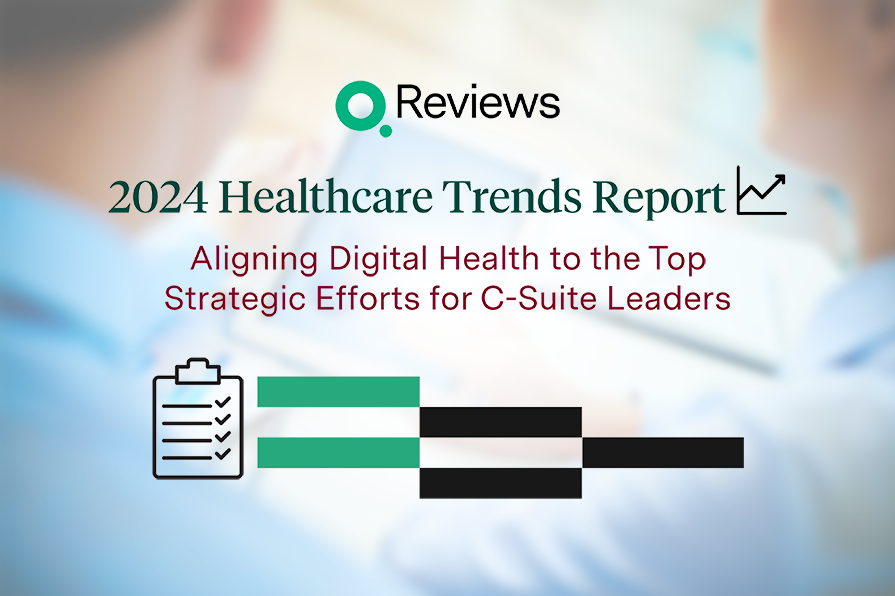
2024 Healthcare Trends Report: Using Digital Health Tools to Solve Healthcare Challenges

At a Glance
| The Challenge | Why It Matters | What You Can Do |
| Patients, providers, & payers alike are struggling with high costs, inadequate care, & staffing shortages. | Going back to basics while up-leveling your digital infrastructure helps you: 1. Reduce costs 2. Improve patient satisfaction 3. Increase revenue | Leverage digital solutions before, during, and after care to: 1. Optimize clinical operations 2. Mitigate administrative burden 3. Identify & address health disparities 4. Improve ambulatory services 5. Accommodate more patients |
Although 2024 has just begun, it’s clear that recent healthcare challenges aren’t likely to go away anytime soon. Consider, for example, that over 70% of Americans say that the US healthcare system is failing them. It’s not just patients who are encountering difficulties, though — payers and providers alike struggle with major issues like staffing shortages, rising costs, and an increasing number of bankruptcies. Fortunately, digital engagement tools can play a significant role in helping organizations stay on top of these healthcare trends.
In the wake of the COVID-19 pandemic — a time when the US healthcare system was completely upended — many healthcare organizations thought that it would take a radical re-thinking of operations to right the ship. But over the past few years, the big bets payers and providers have made (such as switching to remote-first caregiving) don’t seem to have paid off in the way they hoped for. Perhaps it’s no surprise, then, that the primary healthcare trends for 2024 center on getting back to the basics.
After analyzing dozens of industry reports over the past couple of months, we’ve uncovered five primary areas of focus for healthcare executives in 2024: streamlining clinical operations, reducing administrative overhead, addressing social determinants of health (SDoH) disparities, leveraging ambulatory care, and serving a greater number of patients.
While going back to the basics is a good start, however, it’s not enough on its own. Returning to business as usual without making changes means that you will likely just encounter the same problems you did initially. This time around, healthcare organizations must work smarter, not harder — and digital health solutions are the key to doing so. Below, we’ll walk through the ways that you can leverage digital health solutions across the patient journey to overcome healthcare challenges and stay on top of healthcare trends in 2024.
5 Top Healthcare Trends for 2024 & How to Address Them
1. Optimize Clinical Operations
| Pre-Care | Point of Care | Post-Care |
| Pre-procedure & appointment prep | Real-time patient feedback | Two-way patient/provider communication |
Healthcare organizations often make the mistake of thinking that streamlining clinical operations can only be achieved by hiring additional staff, leaving them at a loss when their budgets don’t permit it. Digital health solutions, however, are a cost-effective, low-lift way to alleviate the pressure on clinical teams throughout the entire care journey. Take, for example, the example of a patient who will be receiving a hip replacement.
Digital health tools can play an important role in preparing patients for procedures and appointments. Using a solution like Q Notify, providers can send not only instructional PDFs, videos, and other resources to patients’ mobile devices, but also send surveys to them on the day of the appointment to ensure that they have followed important instructions like fasting and taking any necessary medication — allowing clinical staff to get right down to providing care as soon as a patient arrives.
At the point of care, digital engagement solutions like Q Visit, a patient rounding platform that gathers real-time patient feedback can also help clinical staff operate more efficiently. Q Visit sends patients links to surveys via SMS text message, then aggregates their responses in web-based dashboards. High-priority issues are also automatically flagged, allowing clinicians to concentrate their efforts where they’re needed most.
And once a patient has been discharged, Home care coordination tools like Q @Home that provide a smart chat experience can help clinical staff keep tabs on patients at scale through automated wellness surveys. If a patient does have any pressing concerns — say, an infected wound — they can even send pictures to clinical staff, allowing them to address the issue before it escalates, helping to reduce the risk of time-consuming and costly readmissions.
2. Mitigate Administrative Burden
| Pre-Care | Point of Care | Post-Care |
| Digital FAQs | Smart task routing | Automated patient follow-up |
Another one of the top healthcare trends we identified in 2024 was mitigating administrative strain — something that digital engagement solutions can help tremendously. While digital tools like these can’t replace administrative staff, they can help those staff members deflect, optimize, and automate their tasks for greater efficiency.
Solutions like digital front door (Q Reach) that digitize frequently-asked questions, for example, allow patients to access information around hours, location, insurance plans accepted, and more by self-service. This allows administrative teams to spend less time responding to routine queries and more time focusing on higher-level tasks.
Similarly, digital health solutions with smart task-routing capabilities help decrease the degree to which administrative staff must coordinate among different frontline teams. Patient requests to increase the temperature of their rooms, for example, can be automatically directed right to the facility team — while issues that require medical knowledge, such as pain management, can be forwarded to clinical staff.
And perhaps the biggest opportunity area to mitigate administrative burden is in the post-care stage. Care coordinators are frequently tasked with following up with dozens of patients, which is tedious and inefficient. By sending out automated follow-up messages and surveys to lower-risk patient populations, care coordinators’ time is freed up to focus on manually contacting the patients who need it most.
Related: How Remote Patient Monitoring Can Improve Health Outcomes
3. Identify & Address Health Disparities
| Pre-Care | Point of Care | Post-Care |
| Screen for SDoH vulnerabilities | Connect patients with resources | Survey patients for feedback |
One of the defining healthcare trends of recent years has been a commitment to eliminating the healthcare disparities that so many patient populations face. With the recent launch of the CMS Framework for Health Equity, addressing these healthcare challenges has become more important than ever for providers’ and payers’ bottom line.
The first step to overcoming these hurdles is simply understanding them. Incorporating a digital survey into your check-in process that screens for common SDoH vulnerabilities around housing, transportation, nutrition, environmental factors, and more can help your organization identify and prioritize the biggest obstacles your patients face.
Once these patients are actually at the site of care, you can educate them about and connect them with any resources your organization offers or knows about, such as medical transportation services, food distribution programs, and domestic abuse support groups.
After a patient has left the site of care, you can leverage digital patient follow-up tools to check in and see if they were able to access the resources you shared with them, how those services addressed their needs, and if any new obstacles to care have presented themselves.
Rather than just checking in immediately following an acute care episode, you may want to schedule these follow-ups to occur at regular intervals. It’s rare for SDoH issues to be immediately resolved — many of them require ongoing education and intervention. Even if your organization can’t regularly reach out to patients with SDoH vulnerabilities on an individual basis, digital health solutions can allow you to support them in a scaleable way.
4. Improve Ambulatory Services
| Pre-Care | Point of Care | Post-Care |
| Increase awareness & discoverability | Keep caregivers in the loop | Gauge patient satisfaction |
While ambulatory center closures were among the most notable post-pandemic healthcare trends, overwhelmed organizations are once again turning to them as a key component of their care delivery strategy as healthcare challenges mount. Ambulatory surgery centers are projected to grow by 12% in the next five years, and 22% in the next 10.
One of the chief obstacles these ambulatory centers face — especially those that have only recently opened — is a lack of awareness. Centers like these often face stiff competition, both from other outpatient facilities as well as hospitals. Digital health solutions that facilitate marketing campaigns, showcase patient reviews, and re-activate dormant patients, however, can all help ambulatory centers cut through the noise to win over new patients.
Related: How Healthcare Organizations Can Boost Digital Discoverability
When it comes to care delivery, digital health tools can also play a valuable role in streamlining patient throughput. To truly deliver on their promise of convenient, one-day service, ambulatory centers must be able to quickly move patients from intake to checkout — even with procedures that require anesthesia and, by extension, patient pick-ups. Digital engagement solutions that keep caregivers up-to-date on patients’ status help ensure that patients can check out and leave the facility as soon as they’re ready, freeing up room and bandwidth for other patients.
Digital post-procedure satisfaction surveys, meanwhile, allow outpatient facilities to identify opportunity areas and act on them with immediacy. While traditional phone and mail-based surveys suffer from low response rates and long turnaround times, sending digital surveys via the channel patients already use every day — mobile device — results in higher engagement and instantaneous insights. As a result, outpatient facilities can correct issues as soon as they become aware of them — before they become systemic healthcare challenges.
5. Accommodate More Patients
| Pre-Care | Point of Care | Post-Care |
| Virtual waiting rooms | Streamline discharge planning | Offer ongoing at-home care for chronic conditions |
Between longer patient stays and increasingly tight margins, healthcare organizations have no choice but to increase patient volume to stay financially solvent. Although widespread staffing shortages and budget constraints add a layer of complexity to the matter, employing the right digital health tools can help healthcare organizations amplify their efforts and rise to the challenge.
With virtual waiting rooms, for example, providers don’t even need to have larger facilities to accommodate higher patient volumes. Allowing patients to check in remotely and receive alerts when their provider is ready to see them lets them wait from the comfort of their car while avoiding crowded, uncomfortable waiting rooms.
Related: How to Streamline Patient Throughput
Initiating a digital discharge planning process where patients can review instructions and complete forms ahead of their formal checkout further alleviates congestion at the site of care and expedites patient flow. And rather than having every single specialist speak with patients before discharge — physicians, nurses, pharmacists, nutritionists, physical therapists, etc. — you can survey patients to see which ones they want to speak to before heading home. While patients need to be informed, you also don’t want to overwhelm them with so much information that nothing sticks.
For those patients who require ongoing care for chronic conditions, digital engagement solutions present a sustainable way to offer long-term remote support. For example, sending diabetic patients educational resources, checklists, and informational videos can help them better manage their condition via lifestyle, while regularly soliciting blood glucose levels lets their providers monitor their progress and intervene when necessary — all without taking up inpatient resources.
Address Healthcare Trends Head-on in 2024
While the ideas we shared above are far from an exhaustive list, they should provide a good jumping-off point as you think of how to capitalize on digital health tools. To go a step further, try mapping out all of the different patient touchpoints throughout the three main phases of the care journey — pre-care, point of care, and post-care — to see where digital tools can fit into your organization’s workflow.
Although digital health solutions are no substitute for skilled, dedicated healthcare workers, they are an incredibly valuable tool. The healthcare organizations that make use of them today are well-positioned to stay on top of the most important healthcare trends of 2024 and beyond.








